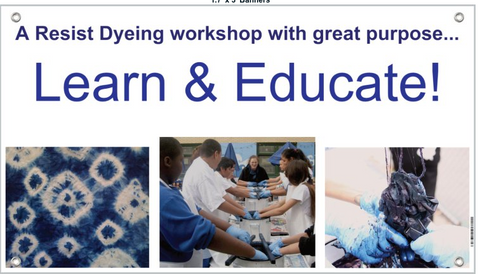News
Very Exciting News! September 21, 2019 08:43
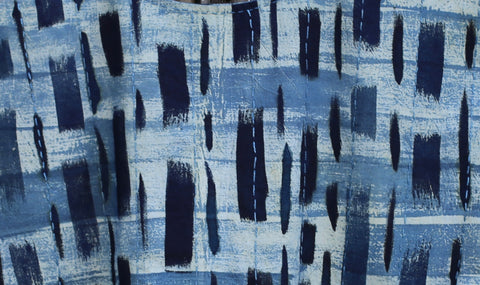
I am completely over the moon!! My indigo garment has been accepted for an exhibition in Tokushima, Japan!
The piece is titled Blueness/Oneness. The inspiration came from many places. A coming together - a celebration - of many cultures!
It’s All About Red! September 13, 2019 12:54
I am often asked “what is your favorite natural dye?” – besides indigo. That is hard to answer – I love them all.
One of my favorites though is Cochineal (Dactylopius coccus), a scale insect that produces Carminic Acid, known as Natural Red 4, or Carmine, it is used to color textiles, foods and cosmetics. It is my understanding that the insect ingests the juices of the Nopal cactus (its host) these ingested juices then mix with the insect’s stomach acid to produce carminic acid.
It's All About Madder! September 9, 2019 04:28
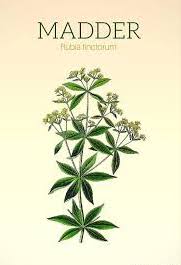
Let's talk about Madder - Rubia tinctorum - the root that gives us peachy pink to orange to true red!
It's All About Color - Bugs, Plants and Extracts March 10, 2019 09:30
Natural Dyes available at The Yarn Tree

The Blues - Indigofera tinctoria from Southern India, Indigofera suffruticosa from Central America, Indigofera tinctoria from Living Blue in Bangladesh and European Woad
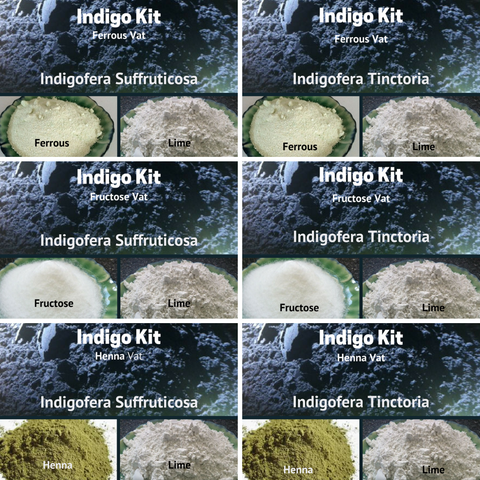
Indigo Kits - You can choose Ferrous, Fructose or Henna and you can select Indigofera Tinctoria or Indigofera Suffruticosa. Would you like a Woad kit? Just ask, we’ll put one together for you! The kits come with a full set of instructions for making, maintaining and reviving the vat
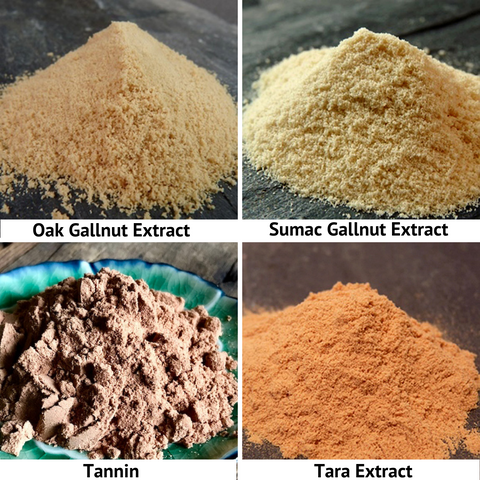
Here are some "clear tannins", tannins that give little color but play an important role. These 4 tannins impart little color and are used to aid in mordanting cotton along with Aluminum Acetate, they impart a wide range of grays with an iron after-bath and in conjunction with Titanium oxalate an array of oranges! So don’t overlook these quiet but important aids to your color palette!
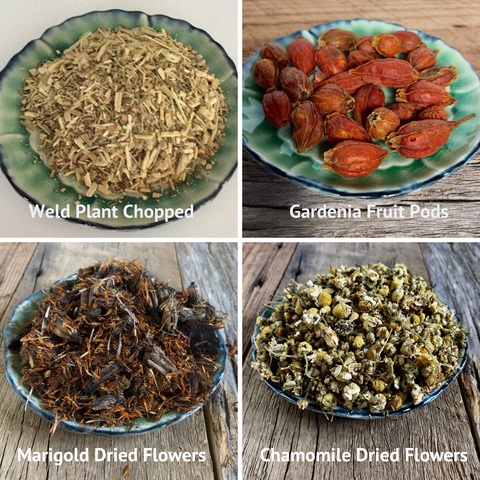
Working with the actual plant material is so much fun and always makes my studio smell great! These are 4 plant dyes that produce different and beautiful lightfast yellows!
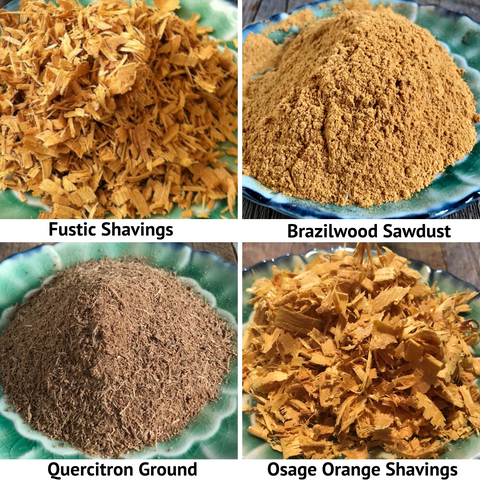
Here are four sustainably harvested woods that give a wide range of lightfast and wash-fast yellows. Over-dye with indigo for a wide range of greens.

Here’s a look at roots, nuts and fruit that give color. Madder root gives oranges to reds to purples. Kamala is the soft powder on the outside of the fruit and gives golden yellow to tangerine. Over-dye with indigo for forest green. And finally walnut hulls are high in tannin and produce butternut to umber and dark brown with an iron after-bath.

BUGS! The Cochineal insect lives on the Nopal Cactus. While they can be found in the wild, today most Cochineal is produced on farms in Mexico, Peru and the Canary Islands. The insect produces Carminic acid and the dye ranges from softest pinks to brilliant reds! Cochineal colors more than fibers - it colors food and beauty products as well.

Tannin can be found in roots, wood, bark, leaves, galls and the skin of certain fruits. These four are in extract form, all with a high rate of tannin and produce color. Cutch produces caramel to coffee brown, Chestnut produces parchment to elephant grey - over-dye with indigo for mallard green. Myrobalan produces butter yellow to grey green - over-dye with indigo for teal. And finally we have Pomegranate which produces gold to khaki - dip in an iron after-bath for moss green.

All four of these extracts have a high tannin content (30-60%) and produce color. Acacia (Wattle) produces ash rose to nutmeg. Persian Berries produces yellows and beautiful greens with an indigo over-dye. Quebracho wood is some of the hardest wood! Q-red produces peach to pink and Q-yellow produces yellow.

These 6 extracts are known for their color! Why extracts? When you use the actual plant matter it takes 100-200% WOG. When using extracts the percentage is much, much lower (2-15%). What I especially like about extracts is how easy it is to develop replicable color formulas (True Red – 15% madder extract + 2% Cochineal extract). Chlorophyllin produces apple green. Cochineal, the colors range from the softest pink to brilliant red. Lac - pink orchid to crimson to burgundy. Logwood produces purple to blue to grey to black. Madder gives us orange to brick red to purple. And finally, we have Weld giving us the clearest yellow and amazing greens when over-dyed with indigo.
My Love Affair with Indigo February 26, 2018 08:51
My love affair with Indigo began many years ago. It was when working with silk dyes that I needed to find an alternative dye source as I began to have a bad reaction to the chemical dyes.
At about the same time, I moved to New Mexico where I had the opportunity to be exposed to natural dyes being used to dye yarns for the beautiful woolen rugs being produced there.
As I studied the plants of New Mexico, and learning their uses both for color and medicine, I began forming a long-term goal of working with natural dyes.
For many years I was a dabbler – experimenting, studying and reading about these fascinating dyes.
Fast forward to August 2001 when I opened The Yarn Tree, a retail store selling yarn, fiber and dyes and studio in Brooklyn, NY. I suddenly had space where I could begin dyeing on a larger scale. I began dyeing yarns to sell in my shop and eventually teaching workshops in natural dyeing. I can still remember my excitement (and nervousness) at working with my first indigo vat – this amazing and magical color that I had studied for so long. My first vats were chemical vats – using natural indigo with a combination of lye and thioureadioxide. These chemical vats gave great color and were not difficult to make but gave off a wretched odor.
Once again fate intervened – I had been living in a tiny rent controlled studio apartment for many years when a large apartment with an outdoor space came available near my store. That spring I set up my first natural ferment indigo vat. I believe it was 15 or 20 gallons in size. This was when I first began to think about the possibility of growing my own indigo but it would be years before I could do so. By the next spring I had taken on a second studio space that was to be my dye studio. Here I set up a 55 gallon natural ferment indigo vat that I kept alive for 5 years.
Unfortunately in 2011 I closed the business and left NYC as I could not recover from the 2008 recession.
I moved to the South, first to Asheville, North Carolina and eventually to Greenville, South Carolina and continued to work with, teach and sell indigo and indigo dyed products.
There is a history of indigo growing in South Carolina. It was first grown on a plantation run by a young woman, Eliza Pinckney, in 1740. She grew Indigofera tinctoria and it took three years before she had a successful crop. Indigo then became an important cash crop for the South until the American Revolutionary War!
Knowing that the climate here successfully hosted indigo growing I decided to finally pursue my long held dream of growing and using my own indigo.
I purchased Japanese Indigo seeds (Polygonum tinctorium aka Persicaria tinctoria) from Rowland Ricketts and got ready to plant.
My first planting was very small – an almost heart shaped spot on my front lawn where once had been a large tree since removed. I had a successful crop and used the fresh indigo leaves to dye silk scarves.
For year two I decided to expand and purchased the materials to make four raised beds each 42inches X 42inches. I set these up on my front lawn. Again I had a very good crop. The first harvest was used to do fresh leaf indigo dyeing and the second was grown for the seeds.
My next goal is to expand my growing area and I am hoping to get my hands on some Indigofera tinctoria seeds. I want to grow Indigofera tinctoria and make my own indigo cakes!
I have had the opportunity to teach indigo dyeing (and natural dyeing) in many parts of the world including two workshops at IndigoSutra in Kolkata this past November.
For me it was a natural progression to go from experimenter to dyer to grower.
But why this fascination with indigo?
I like to say that Indigo is as old as time, we know it has been in use for several thousand years. It is grown all over the world – just different species – Indigofera tinctoria, Indigofera suffruticosa, Indigofera guatemalensis, Persicaria tinctoria to name a few.
Each culture has their own method of going from green plant to dyestuff whether it be fresh leaf, balls, cakes, paste or sukumo. Each culture has its own way of making an indigo vat with their very own special and sometimes secret ingredients. Yet we all produce the same color – Indigo Blue. Each culture has great respect for indigo and most honor the Indigo god with offerings, altars and sacrifices. And indigo has many names Anil or Nil – thought to be after the Nile River, Indigo coming from the word India and in Japan it is known as Ai or Aizome.
Indigo is surrounded with both myth and superstition. In some cultures only women are the dyers and others only the men. It is a color worn by both peasants and royalty.
And it has medicinal properties. Here are several – an indigo dyed cloth wrapped around your forehead will alleviate a headache, wearing indigo clothing can be calming, it is a natural bug repellent and it can be used to reduce fevers.
Indigo commands respect. By this I mean that one cannot be in a bad mood or rushing when working with indigo – you will not have good results. You must be patient. Having a natural indigo vat is like caring for a child or a pet – it cannot get too cold or hot and must be fed. Well-maintained indigo vats will survive for years and years. It is said that there are 100 year-old indigo vats in Japan.
For me indigo is more than just the color blue, it is a way of life.
Linda LaBelle
Traveling to India in Search of Indigo! June 14, 2015 07:10
INDIGO SUTRA celebrates Indigo, the world's oldest, most widely used and unique dyestuff, and the only natural blue dye.
The increasing awareness of using organic products in a highly polluted world has led to the current desire to use sustainable indigo for clothing and other textiles. INDIGO SUTRA is a milestone project, using expertise and guidance of top scholars, academics and practitioners of indigo from across the world.
The event will focus on the production and use of natural indigo, with seminars, exhibitions, demonstrations, workshops, discussion forums, documentary film shows, sale of indigo based textile and other products.
IndigoSutra takes place in Kolkata, India on November 9, 10, 11, 12 2017
While there I will be teaching two workshops!
